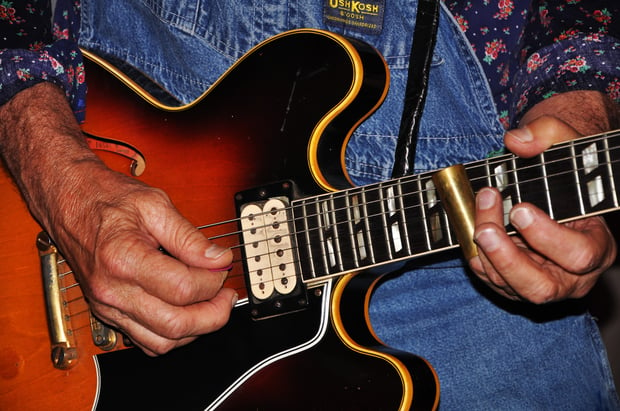 Photo by Carl Lender via Wikimedia Commons / CC BY 2.0
Photo by Carl Lender via Wikimedia Commons / CC BY 2.0
Nobody likes to experiment more than a guitarist. Weird tunings, oddball effects pedals, and strumming on the springs of your tremolo are probably all things you’ve tried before. Chances are, you’ve also picked up a glass bottle or a short length of pipe and tried to play slide. There’s also a good chance that you weren’t thrilled with the results. Capable slide playing requires some solid left-hand techniques, and that will come with practice. But there are also a few tricks that will help you follow in the footsteps of Bonnie Raitt, Ry Cooder, and Duane Allman. (For the why of it, see this article.)
1. Change your target
We fretted-instrument folks are spoiled (as fretless bass players like to remind us) because we don’t have to worry about intonation. We just tune up the instrument and follow the frets. But a guitarist’s pitch is as good as any cellist’s; we just need practice.
When playing slide, the fret becomes the target, not the space between frets. For example, to play an F sharp on the low E string, you need to position the slide directly above the second fret, not between the first and the second. Essentially, your slide becomes the fret. This takes a little getting used to, but only a little. It will also improve your ear.
2. Raise your action
If you have a guitar you’ll be using for slide playing, adjusting the action might be necessary. You’ll know it when the pressure of the slide makes the strings ground out against the frets. This means it’s time to give up your super-slow shredding action and raise up those strings.
At the bridge, take a hex key and adjust your saddles upwards. You’ll need to raise your action at the nut end as well. You don’t need to buy or fabricate a new nut; you can just "shim" the current one by putting something underneath. If you haven’t done this before, it’s easy. With the strings off the guitar, take a screwdriver and a hammer and very gently tap the nut out from the side. Cut one or two strips of cardboard (depending on thickness) to fit inside the nut slot, beneath the nut. Put a drop or two of regular white glue on each layer and smear it flat. Then, reassemble the newly-shimmed nut and restring the guitar. The action should be the same at the nut and bridge ends, so eye it up carefully from the side. Adjustments can be made easily by raising or lowering the saddles. Now your slide should be able to compress the strings slightly without any muting from the frets.
3. Try open tunings
Slide players love their double-stops. Nothing’s sweeter than hearing two singing strings with a little distortion as you bend into the notes. This is often easier when using an open tuning (a tuning that forms a chord when strummed in the open, unfretted position). Many slide players prefer open G. From low to high, the strings are tuned to D G D G B D. Of course, you don’t need to play in the key of G to use this tuning, but it does give you a nice low growl when you pick the low, wound strings unfretted! If you let a string ring out by mistake using an open tuning, at least it will usually be in the same key.
4. Work on your right-hand muting
Most rookie slide players let a lot of strings ring out at once, resulting in a bunch of out-of-control drones and noises that remind us of someone taking his first lesson on bagpipes. Unlike fretted playing, slide playing creates more noise because the slide tends to strike all six strings at once. It’s essential to isolate the notes you want by muting the other strings with your right hand. Like many skills on the guitar, this is something that seems difficult at first and quickly becomes second nature. The big muscle of your right thumb and the heel of the right hand are your tools for muting and isolating the correct strings. With a few days of practice, you’ll naturally mute whichever strings you don’t want to hear.
5. Work on pinpoint control
Good slide playing is accurate slide playing. Even a guitarist like George "I Drink Alone" Thorogood, whose slide parts seem fairly simple, sounds great because of his perfect intonation and strong rhythm. To tackle tougher parts like Duane Allman’s singing leads or Bonnie Raitt’s soulful fills, you’ll need to be mathematically precise with your slides, vibratos, and hammer-ons. Don’t get discouraged, and keep working! Slide playing will add new tones, more diversity, and greater expression to your guitar playing. Want proof? We’ll just leave you with this right here:
Jesse Sterling Harrison is an author, recording artist, and part-time farmer. He lives in Massachusetts with his wife, three daughters, and a herd of ducks.







